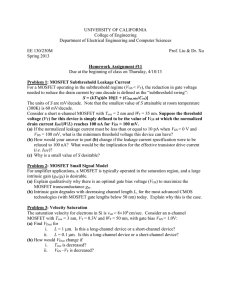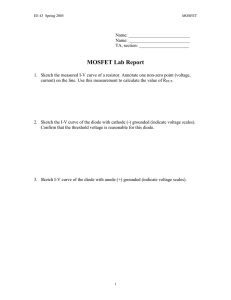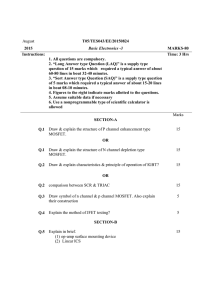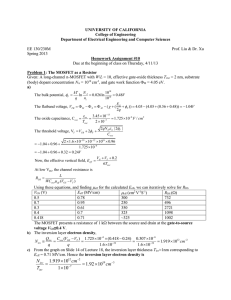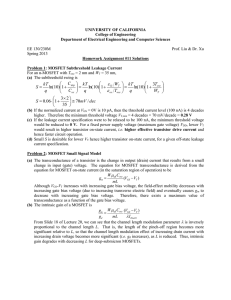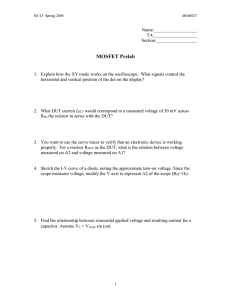EECS 40, Fall 2007 Prof. Chang-Hasnain Homework #10
advertisement
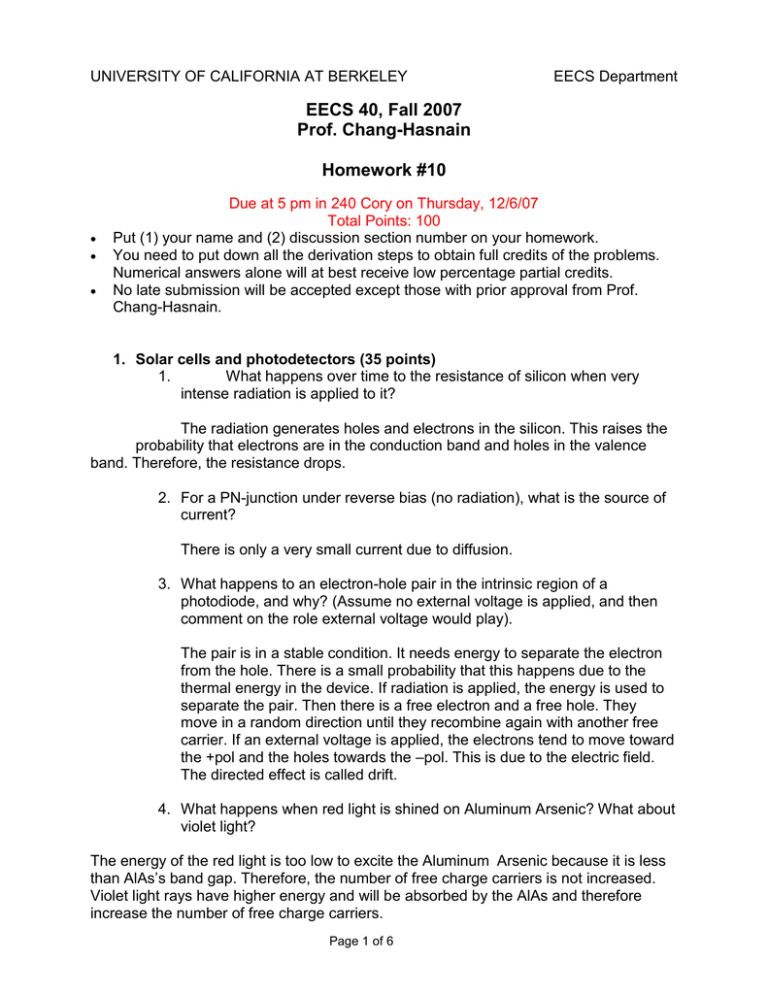
UNIVERSITY OF CALIFORNIA AT BERKELEY
EECS Department
EECS 40, Fall 2007
Prof. Chang-Hasnain
Homework #10
Due at 5 pm in 240 Cory on Thursday, 12/6/07
Total Points: 100
Put (1) your name and (2) discussion section number on your homework.
You need to put down all the derivation steps to obtain full credits of the problems.
Numerical answers alone will at best receive low percentage partial credits.
No late submission will be accepted except those with prior approval from Prof.
Chang-Hasnain.
1. Solar cells and photodetectors (35 points)
1.
What happens over time to the resistance of silicon when very
intense radiation is applied to it?
The radiation generates holes and electrons in the silicon. This raises the
probability that electrons are in the conduction band and holes in the valence
band. Therefore, the resistance drops.
2. For a PN-junction under reverse bias (no radiation), what is the source of
current?
There is only a very small current due to diffusion.
3. What happens to an electron-hole pair in the intrinsic region of a
photodiode, and why? (Assume no external voltage is applied, and then
comment on the role external voltage would play).
The pair is in a stable condition. It needs energy to separate the electron
from the hole. There is a small probability that this happens due to the
thermal energy in the device. If radiation is applied, the energy is used to
separate the pair. Then there is a free electron and a free hole. They
move in a random direction until they recombine again with another free
carrier. If an external voltage is applied, the electrons tend to move toward
the +pol and the holes towards the –pol. This is due to the electric field.
The directed effect is called drift.
4. What happens when red light is shined on Aluminum Arsenic? What about
violet light?
The energy of the red light is too low to excite the Aluminum Arsenic because it is less
than AlAs’s band gap. Therefore, the number of free charge carriers is not increased.
Violet light rays have higher energy and will be absorbed by the AlAs and therefore
increase the number of free charge carriers.
Page 1 of 6
UNIVERSITY OF CALIFORNIA AT BERKELEY
EECS Department
5. Suppose you know the amount of incident light, so that I D= f(VD) (see
second figure below). Write down the equation you would solve to find the
operating point that maximizes power. Then write the resistor you would
choose in terms of vopt and f(Vopt) in order to achieve this operating point.
dP/dV= d/dV(f(V)*V)=0
Solve for this to find vopt
R = vopt/f(Vopt)
6. Suppose you have a number of curves, each corresponding to a different
amount of incident light, and you are trying to maximize the amount of
power generated. What would it mean if the curves ever intersected?
What does this tell us about our ability to determine the amount of incident
light (assuming we knew the curve for every value of incident light)?
The curves intersecting means that for different amount of incident light you get the
same output voltage & current. That shouldn't happen. So we can always determine the
amount of incident light uniquely, assuming we can measure precisely.
2. Analysis of an Amplifier (65 pts)
Amplifiers are essential building blocks in analog circuits and can be found in
almost all electronic devices. Amplification requires the usage of nonlinear devices such
as bipolar junction transistors (BJT) or metal oxide semiconductor field effect transistors
(MOSFET). In this homework, you will fully analyze an amplifier based on a MOSFET.
Before starting with this homework, you may want to read chapter 12 of the textbook.
Geometry of a MOSFET (10 pts)
a. Sketch the model of an n-channel MOSFET. Clearly identify which regions
are n and p doped. Also, mark the terminals. (5 pts)
b. Explain the principal operation of the MOSFET. Is the charge through the
channel transported by holes or electrons?
Page 2 of 6
UNIVERSITY OF CALIFORNIA AT BERKELEY
EECS Department
For NMOS, as the gate-body voltage increased above a certain
positive value (called threshold voltage Vto), a thin layer of
electrons is formed at the oxide-Si interface. This layer is
called the inversion layer, which forms a bridge to conduct
electrons from source to drain. As the channel is n-type, with
electrons as the conducting carriers, this type of MOSFET is
called N-MOSFET. Current can flow from the drain, through the
channel, and out the source if a drain to source voltage, VDS, is
applied. You may notice that the terms “source” and “drain” seem
to be backwards. This is because they are the source and drain
of carriers, which in the case of a NMOS are electrons.
For PMOS you have a negative voltage (relative to the body)
applied at the gate, so holes congregate at the interface. These
conduct.
II Large Signal Model of MOSFET (25 pts)
c. In which modes can a MOSFET be operated. In which mode is the
MOSFET a good amplifier?
MOSFET can be operated in cutt-off (VGS < Vto), triode (VGS > Vto
and vDS < vGS – Vto), or saturation (VGS > Vto and vDS > vGS – Vto). MOSFET
is a good amplifier in saturation mode.
The analysis of an amplifier is usually divided into the DC analysis and the AC
analysis. For both analyses, we have draw equivalent circuits. We will first consider DC
equivalent circuits.
d. In DC equivalent circuits, capacitors, coils, AC voltage sources, and AC
current sources may be replaced by DC equivalents. Fill out the following
table:
circuit element
DC equivalent
Explanation
short
V = L di/dt, so in steady
state where i is constant
V=0.
open
Capacitor will charge until
in steady state; then no
current flows.
Coil
Capacitor
AC current source open
AC current source does not
allow the flow of a DC
current, hence open circuit.
Page 3 of 6
UNIVERSITY OF CALIFORNIA AT BERKELEY
EECS Department
(Or think of using
superposition).
AC voltage source short
DC voltage across an AC
voltage source is 0, so
short. (Or think of using
superposition.)
In the following we will analyze the following single stage amplifier circuit:
e. Draw the DC equivalent circuit for the given circuit. The source vs is an AC
voltage source.
We open all capacitors. Rs and R7 become useless and Vs does not
affect the circuit. Thus the DC equivalent contains R1, R2, Rd,
R5, R6 and the MOSFET hooked up to Vdd.
Aim of the DC analysis is to calculate the Q-point of the transistor, i.e. the voltage
between drain and source and the current through the channel. The Q-point can then be
used to calculate the transconductance and the drain resistance of the MOSFET which
is needed for the small signal analysis.
f. Calculate the voltage between the drain and the source as well as the
voltage between the gate and the source. Further, calculate the current
through the channel of the MOSFET. In which mode is the MOSFET
Page 4 of 6
UNIVERSITY OF CALIFORNIA AT BERKELEY
EECS Department
biased? The transistor is an n-channel type. For this complete exercise,
use the typical values of an MOSFET as given in the table on page 581 of
the textbook, and assume K = 1 mA/V^2.
Using Voltage divider equation we find Vg=R1/(R1+R2)*12=4.9 V.
Use VGS = VG – 12kΩ ID and ID = K (VGS – Vto)^2 to find {Vgs -> 0.386725}, {Vgs ->
1.52994}. IF Vgs=.3867, it is below threshold and our assumptions don’t hold, thus Vgs
-> 1.52994. ID = K (VGS – Vto)^2= 0.280836 mA. We can finally back out Vds=1234kΩ*.28 mA= 2.462 V.
We can see that this satisfies the conditions for saturated mode,
which validates our assumption. i.e. VGS > Vth and VDS > VGS
- Vth
IV CMOS Logic Gates (30 pts)
Apart from the application in amplifier circuits, MOSFETs are also the most
important building blocks of logic circuits. A modern graphical processing unit, for
instance, contains more than 120 million transistors. Apart from the already discussed
diode logic, there exists logic gates which are based on BJTs. Further, there exists logic
exclusively using n-channel MOSFETs or p-channel MOSFETs. Our focus, however,
will be on the so called CMOS, which uses both types of MOSFETs.
3. Given is NMOS block of a function
implementing a boolean function. (15 pts)
a) What boolean function is implemented?
Y=not(A+B(C+DE))
b) Draw the PMOS part of the circuit.
Page 5 of 6
UNIVERSITY OF CALIFORNIA AT BERKELEY
EECS Department
4. Construct a circuit which implements Y = A · (B · C + D · E) (15 pts)
The CMOS equivalent is also an acceptable answer.
Page 6 of 6

